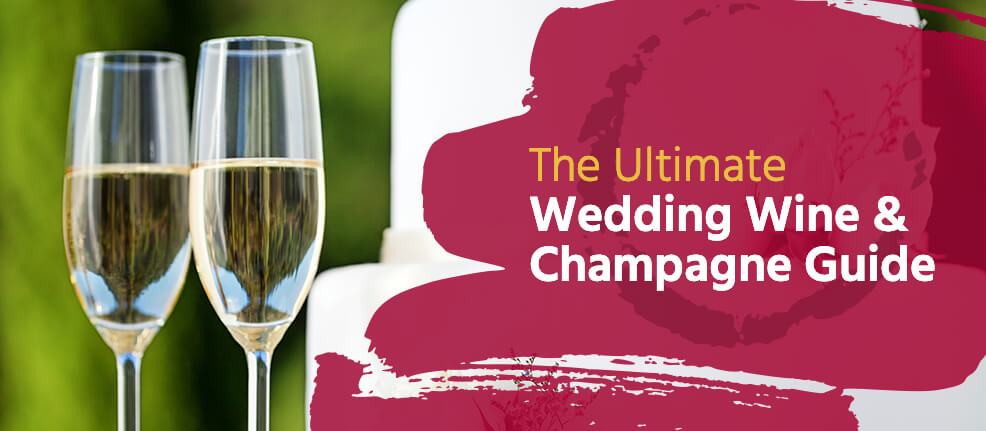
The final touch at every wedding is an elegant champagne toast. However, getting to that point is more complicated than you think. Wine and champagne decisions alone include considering what types to select, when to serve them, plus how many bottles to order without breaking the bank.
De-stress picking and ordering the best wines and champagnes for your wedding day with the insights and calculations below. Our guide to champagne and wine for a wedding explores all the necessary details to nail down this planning task so you can move onto other decisions. You know, like enjoying one of the happiest days of your life.
Best Wines for Weddings
To find good wines for weddings, look for lower alcohol content and a mild flavor that will pair nicely with your reception meal. Give your guests options by choosing at least one red and one white wine. Two foolproof options that can be served year-round are Pinot Noir and Sauvignon Blanc. Both wines are lighter in body with a subtle fruitiness that goes well with a variety of foods.
Sauvignon Blanc and Pinot Noir are excellent wedding wines, but there are other great options like Pinot Grigio and Cabernet Sauvignon. The best choice will depend on your taste and wedding menu. We’ll cover more wine options and food pairings below.
Questions to Ask When Planning Your Wedding Alcohol Menu
Before calculating the exact amount and types of wine and champagne to order, consider these larger menu questions.
- Serving other drinks options: Wedding wine and champagne may not be your only beverage options at your reception. Many couples also choose to serve beer alongside mixed drinks at an open or cash bar, giving guests plenty of options. Some go all-out and provide beer kegs, which are especially popular at outdoor summer weddings. As the best wedding rule of thumb, always determine your full drink or bar menu before going down the wine-ordering rabbit hole. Plan to order generously if wine is the only beverage on the menu, as your guests will drink it all night.
- Assess your guest list: Your guest list plays an important role in the type of beverages served and the amount of wine and champagne needed. As friends and family, you know these people best. Do most of them drink? Do many of them not drink at all? Do your guests prefer beer or other drinks to wine and champagne? Will they stay and party long into the night, or will many of your guests leave early? Use these factors to help calculate wedding reception wine and champagne quantities.
- Remember not to sweat leftovers: This is especially true if you order your own bulk beverages rather than go through the venue or caterer. Stock your own mini-bar at home with bottles or cases of leftover wine if it turns out you were generous with your calculations. You can give bottles out as gifts for upcoming occasions. No harm, no foul.
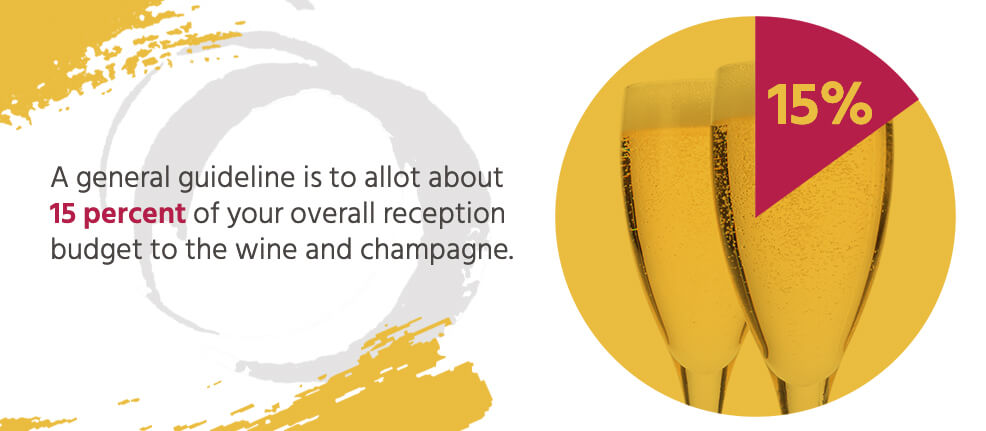
- Set a budget: Alcohol represents only a fraction of your overall wedding budget. Determine early on your comfortable spending limits on wine and champagne. From there, you can explore specific red and white varietals or brands. A general guideline is to allot about 15% of your overall reception budget to the wine and champagne. Try not to worry if that gives you sticker shock. Most varieties of wine come at varying price points, starting under $10 per bottle and going up from there. This means you can serve your guest a delicious wine even on a budget.
Calculating Wine and Champagne for a Wedding: The Basics
Always round up when determining how much of these signature celebratory beverages to order.
Erring on the side of caution brings peace of mind on your big day, keeping guests happy and reducing wedding-day stress. After all, your college pals will never let you live it down if the wine, champagne and other beverages dry up too early.
Luckily, there is a formula for how much champagne and wine to order for your wedding. To prepare for those ordering calculations, first review these factors:
- When you plan to serve wine: Are you going to serve wine for the entire reception or only during dinner? If you’re popping corks all night, you’ll need a lot more wine. The same question applies to champagne. Will you only serve one glass per guest for an official couple’s toast, or will you offer it all night at the bar?
- Wedding reception timing: The time of your reception affects how much alcohol people drink. Guests drink less at a daytime wedding as well as Sunday and weekday nuptials. The more traditional evening or weekend wedding means you’ll likely need to increase your wine count, accommodating for friends and family letting loose.
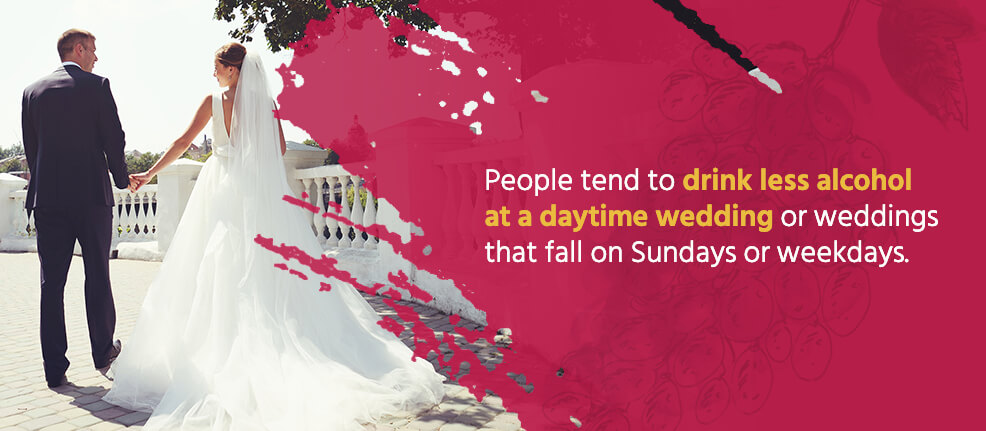
- Wedding reception location: Location is also a factor. If your reception is held at a hotel where guests are staying, they’ll consume more wine than if they had to drive somewhere afterward. Likewise, wedding receptions held at wineries tend to bring out the wine connoisseur in your guests, making them drink more than they might at another venue.
- Other drink options: Will you serve other alcoholic beverages? Will those beverages be free, or do you plan to have a cash bar? If wine is the only free option and you’re serving it all night, guests may opt for that instead of the paid options at the cash bar.
- Who is serving: Self-serving open bars are options for backyard weddings and similar set-ups. If guests are pouring their own wine, increase your order amount. People are a little more generous than bartenders and servers when it comes to pouring their own drinks. If you have a catering staff member or bartender pouring the wine, specify that you want smaller serving sizes. Some inexperienced servers may fill the glasses more than you want, making the wine disappear faster. The containers also influence the size of pours. Large glasses beg for larger servings of wine. Opt for smaller glasses to keep the pour amounts under control.
- Guest preferences: Are your guests wine drinkers, or do the prefer beer? Do you have lots of non-drinkers on your guest list? Knowing what your guest like to drink helps you determine how much of each type of drink you’ll need.
- Guest ages: What is the average age of your guest list? If a third of the guests are underage, you won’t need nearly as much wine as you would for a majority-adults wedding reception.
How Many Bottles of Wine for a Wedding Reception?
A standard wine bottle holds 25 ounces. From that single bottle, you can expect to get roughly four to five servings of wine — or four to five glasses — depending on who is pouring and how much wine goes into each glass. Again, err on the side of caution and round down to four servings per bottle, just to account for those heavy pours.
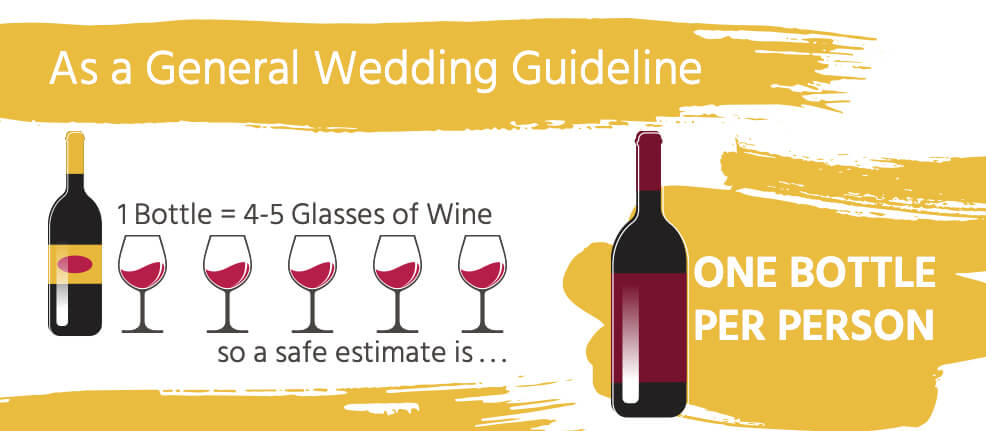
Wedding planners suggest assuming each adult will drink approximately one glass of wine every hour. Wedding receptions, on average, last between three to five hours. Together, we can use these estimates to form the calculation for how many bottles of wine to order for your wedding:
- Wine bottle calculation formula: [Number of legal-drinking age guests] x 5-hour reception / 4 servings per bottle = total number of bottles to order
For an easier calculation — or if you just hate math — default to this guideline — order one bottle of wine per guest above the legal drinking age. For example, 200 drinking-age guests mean 200 total bottles of wine for your big day. Then add 10 to 25 extra bottles atop this one-to-one rule to give yourself a buffer, allowing wiggle room for generous serving sizes.
Sensibly adjust your numbers based on the other factors you considered. For example, if you’re also serving beer and having an open bar, you might not need as much wine. You can also decrease your numbers if a portion of your guest list doesn’t drink. If wine is your only beverage or you have many wine-loving friends, you may want to order even more of your selected varieties.
How Many Bottles of Each Wine Type Should I Buy?
Now that you have a general idea of the number of bottles required, you need to determine how many bottles of each type of wine to buy.
Most people offer at least one white wine and one red wine at their reception. Guests can select the type they most favor and even switch up their selections as the event goes on.
- Order a 50/50 split between your selected red and white varietals: Skew orders toward one type only if you know for sure your guests have a heavy preference.
Remember that wines varietals are often served to match the season. White wines and rosé are more popular in the summer. If you’re having an outdoor or summer wedding, consider ordering slightly more refreshing white wines. Conversely, heavier reds work better in the cooler temperatures of fall and winter. Bump up the amount of red wine you order if your nuptials fall in these seasons.
How Much Champagne for a Wedding Reception?
Champagne is a type of sparkling wine traditionally used for the official couple’s toast at a wedding. For that reason, calculating how much champagne to order comes down to how many guests are at your wedding, as each guest will receive their celebratory pour.
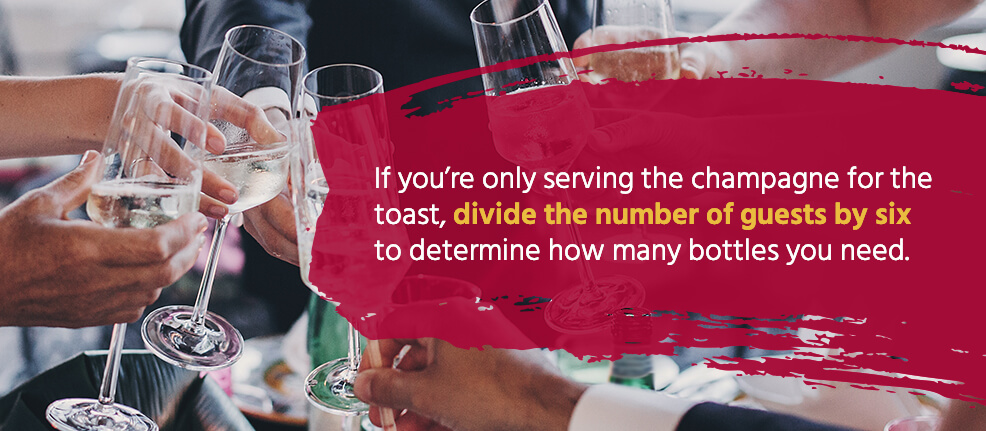
The average bottle of champagne contains about six servings for toasting pours. Therefore, the equation for determining how many bottles of champagne to order for your wedding is:
- Champagne bottle calculation formula: [Number of legal-drinking age guests] / 6 servings per bottle = total number of bottles to order
For 100 people, that’s roughly 17 bottles of champagne. Consider rounding up your figure in case waitstaff pour larger servings. This estimate gives each guest a small serving of the sparkler for the toast — you don’t want guests at the last-served tables to toast empty-handed!
If you plan to serve the champagne or sparkling wine throughout the night, you’ll need more. Use the same methods as you used for the other wine varieties to estimate how much to buy. On the other hand, if you don’t like champagne, consider a bubbly wine option — or skip this formal toast altogether.
Determining Which Wine and Champagne to Pick for Your Wedding
Wine comes in all varieties, from dry to sweet, red to white. If you’re not a wine drinker, you may not know where to start when it comes to choosing the best wines for weddings.
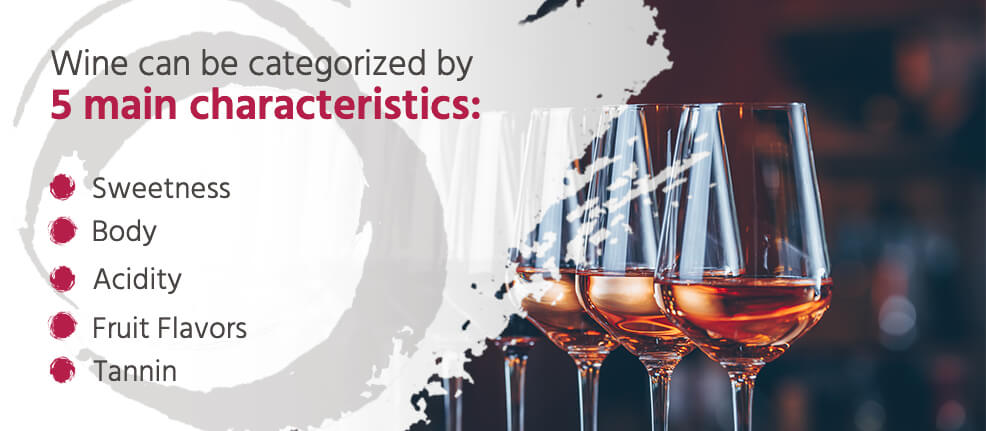
Wine is categorized by many characteristics, including the five below. Learn about these five defining traits and how they affect the wine-drinking experience to narrow down the options for your wedding menu.
- Sweetness: Wines vary in sweetness, from a very dry wine with almost no residual sugar to very sweet, tongue-tingling drinks. Balancing the sweetness level is often a good idea for wedding wines. An overly sweet wine doesn’t usually pair well with foods, and many people don’t like the sugary flavor.
- Body: A wine’s body will be described as light, medium or full. Lighter wines tend to feel more refreshing, while full-body wines have a stronger, more assertive taste that holds up well to many foods.
- Acidity: High acidity in wine is often described as a tart, zesty feeling with a slight tingling and mouth-drying sensation. Lower acidity produces a richer, rounder wine with a smoother aftertaste.
- Fruits: The fruit flavors you taste in a wine are some of its most interesting and unique. Some wines have a lush fruity palate with distinct flavors you can pick out as you sip. Others tend to be less fruity, containing earthy or floral notes.
- Tannins: Tannins are a compound in wine that produces a bitter, sharp reaction when tasting. While not related to dryness or acidity, a wine high in tannins tends to make your mouth feel dry. Some people do not like high tannin levels, but tannin can add complexity and balance to a varietal.
Most Popular White Wines for Weddings
White wines tend to offer a lighter, refreshing and more approachable drink choice. White wine types span from dry to sweet, with many options in between. Once you narrow down a specific variety of white wine, do some tasting of different brands, as the sweetness levels and even some of the aromas vary from one brand to the next.
Today, some of the popular white wines for weddings include:
- Sauvignon Blanc: Sauvignon blanc is light and crisp, offering a refreshing but earthy set of flavors. This adaptive wine pairs well with a variety of foods, including cheese, chicken, oysters, seafood, and vegetables. It’s also appropriate all year long.
- Pinot Gris/Pinot Grigio: Pinot grigio offers a firm, nuanced white wine with pear, lemon, melon and sweet-spicy notes. This light white wine goes well with chicken, shellfish, rich fish and pasta. Italian versions, known as Pinot Grigio, tend to have a steely flavor with good acidity, while the French Pinot Gris provides more flavor complexity with a richer aftertaste.
- Chardonnay: Chardonnay is considered a rich white wine, typically with a creamy texture and intense fruit flavor. If you go with a chardonnay, stick to an unoaked or lightly oaked variety, which has a stronger fruit flavor and brighter acidity. It pairs well with many different types of foods, including vegetables, white fish, shellfish, chicken, pork and veal. It’s also enjoyable on its own.
- Riesling: Another versatile white wine type, riesling offers a crisp, aromatic quality, often with a slight mineral touch. Riesling ranges from very dry to incredibly sweet, so taste different brands to get the type you want. Riesling works well with almost any food, including shellfish, pork, vegetables and international foods.
Best Red Wines for Weddings
Red wine is a classic, sophisticated option popular at weddings as well. As with white wine, you’ll find a wide range of flavors, bodies and sweetness levels within each variety, so it’s always a good idea to taste before you buy.
When it comes to red wine for a wedding, try one of these options:
- Cabernet Sauvignon: Cabernet sauvignon typically highlights flavors of dark fruit, particularly plums, blackberries and black currants. This red wine pairs well with hearty dishes and is the top pick in America for red wines. The full body of cabernet sauvignon works with beef, duck, richly spiced sauces, marinades and other red meat.
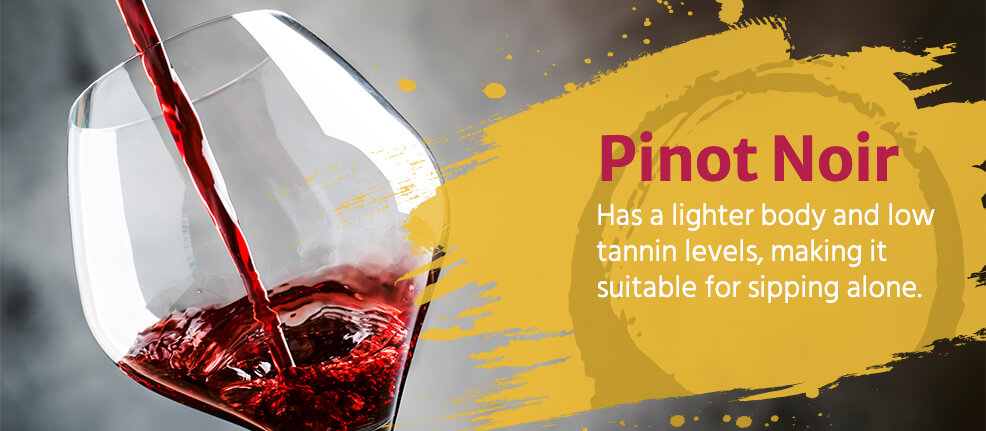
- Pinot Noir: Pinot noir is known as a silky wine, counting berries, cherries, plums, violets and warming spices in its roster of flavors. This varietal has a lighter body than many other red wines and low tannin levels, making it suitable for sipping alone. That light body also lets the wine pair well with a variety of food options, including finger fare during cocktail hour. Try pinot noir with roast chicken, duck, lamb, hearty fish and pork.
- Shiraz/Syrah: Both names represent the same wine — an earthy, fruity red known for its dark fruit and herb notes with earthy accents, such as leather, tobacco and black pepper. Shiraz is considered a big red wine, making it suitable for red meats, pork, lamb, grilled meats and game.
- Zinfandel: Zinfandel is almost exclusively an American wine, with few other locations growing the grapes. It is a bold, zesty red wine with intense flavors, including dark berries, plums, cherries, chocolate and black pepper. Zinfandel also has a high alcohol content, so consider that fact before serving it at your wedding. Zinfandel pairs nicely with spicy foods, grilled meats, red meat and barbecue.
- Grenache: This red wine appears light in color but offers a medium-to-full flavor profile, pulling in stewed berries plus white pepper. Grenache is available on its own or in wine blends. It works well with red meat, lamb, chicken and vegetables.
- Sangiovese: Sangiovese offers a fresh cherry flavor with herbal accents and is often high in acidity and tannins. Newer versions often have lower acidity levels. Sangiovese pairs with chicken, red meat, mushrooms and food with tomato sauces.
Best Rosé for Weddings
For wedding receptions, opt for a dry rosé offering the best of both worlds. Rosés carry the bright, refreshing flavors typically associated with white wine. Yet it also has enough body to stand up to meals and even wedding cake, just like red wine. Plus, this variety of wine is quickly gaining ground to become a premier choice for wedding celebrations, since it falls body and flavor-wise between white and red wine.
Dry rosé tends to have a crisp, fruity flavor without being as sweet as white zinfandel or similar American blush wines. It is a versatile wine option that works in any season and for any time of the day. Rosé is suitable to pair with almost any food options, including chicken, red meat, salads, seafood, grains and vegetables.
Most Popular Champagnes for Weddings
Champagne and sparkling wine are often associated with celebrations, which makes them perfect for weddings. Their subtle flavors and expressive bubbles make sparkling wines a delicious and suitable drink on their own. Dry sparkling wines in particular work well with foods if you want to offer a bubbly option on your beverage menu.
Optimal levels of champagne sweetness depend on personal preference, as well as when you will serve the sparkler. If you plan to serve it during dessert, opt for a sweeter sparkler. A demi-sec is usually a good choice. Dry sparklers tend to taste metallic or bitter when served with sweet foods like your wedding cake.
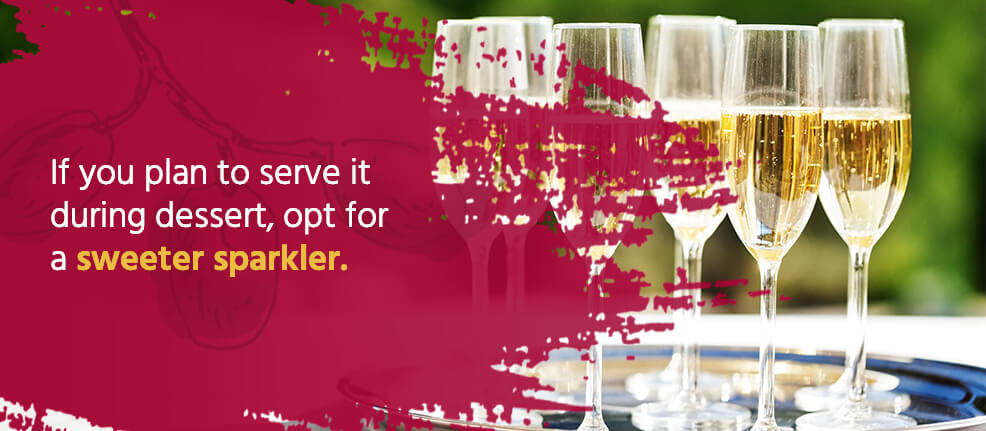
Consider these bubbly beverage options to find the best champagne for wedding activities:
- Blanc de Noir: Blanc de noir is a sparkler made primarily of pinot noir grapes. Some types also use Pinot Meunier. It is generally full of red fruit flavors and has a heavier body than other sparkling wines, with a color ranging from gold to pink.
- Blanc de Blanc: This type of bubbly is 100% chardonnay derived, with flavors to match if it comes from the Champagne region of France. Other white grapes can be used if the wine is made elsewhere. This variety tends to have a light, delicate flavor.
- Metodo Classico: Metodo Classico is a style of making sparkling wine very similar to traditional champagne. These wines tend to have creamy bubbles with a rich body.
- Prosecco: This Italian sparkling wine offers a fruity, aromatic flavor, often with flowery, peachy notes. Prosecco like La Marca Prosecco – 187ml is a bit on the dry side, although it tends to be sweeter than other varieties. Unlike some wines that improve with age, prosecco is better when young.
- Cava: Cava is the Spanish version of sparkling wine. It is produced in the same way as champagne, making it an affordable alternative to its French cousin. Cava tends to have a balanced fruity flavor but is not as sweet as prosecco.
- Sparkling Rosé: Sparkling rosés, also known as Rosato or Rosado, work well with food, as they tend to have a fuller body. These sparkling wines are sometimes made with a combination of still red wine and sparkling white wine. Sparkling rosés range in both color and flavor, from a light to a dark pink and from dry to sweet. Test different varieties before settling on one to get the flavor you want.
Note the only sparkling wine to officially receive the label of champagne must be made in the Champagne region in France. Other names include the more generic sparkling wine, cava, prosecco, Asti and Cremant, each designating where the beverage was produced.
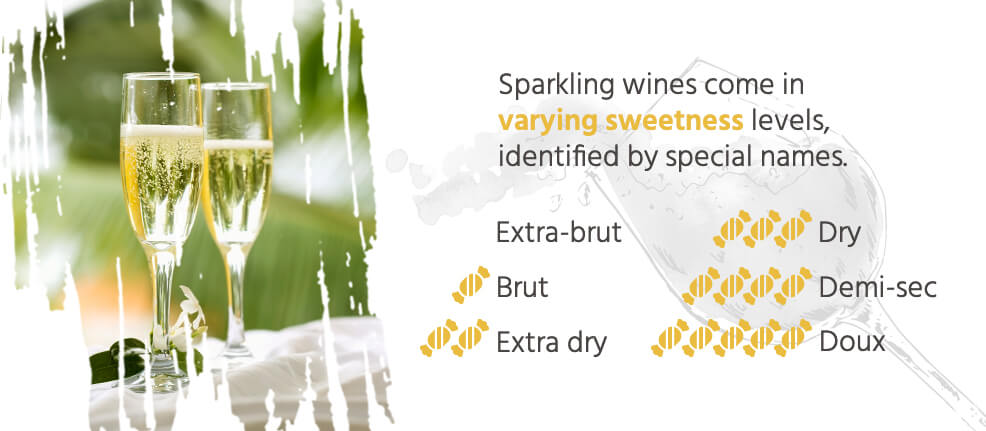
Yet more important than the name or where it originates is the flavor a bottle offers. Sparkling wines come in varying sweetness levels, identified by special names. Explore these different levels to find champagne or sparkling wine that fits your preferences:
- Extra-brut: Driest type of sparkling wine or champagne available; no added sugar
- Brut: Brut wine like Wycliff Brut Champagne – 750ml is very dry with almost no sweetness; up to 1.5% sugar
- Extra dry: Also known as extra sec; a hint of sweetness without being overwhelming; up to 2% sugar
- Dry: Also known as sec; a little sweeter on the palette; up to 4% sugar
- Demi-sec: Sweet option; often considered a dessert wine; up to 8% sugar
- Doux: The sweetest option; up to 10% sugar
Best Food and Wine Pairings for a Wedding
When choosing your wine, consider your food menu for the reception. The best wedding wines complement the main entrée, bringing out even more primary and secondary flavors.
Use these time-tested wine and food pairing guidelines when crafting the final menu for your wedding:
- Chicken: Both red and white wine work with chicken so long as they’re light-to-medium bodied. Anything too heavy overpowers the softer flavors inherent to chicken. If you want a red wine, try pinot noir, Grenache or Sangiovese.
- Beef: Because beef maintains richer flavors and more marbling, pair it with a stronger wine. Medium-to-bold reds are the winners here, with higher tannins and bodies. Think cabernet sauvignon, merlot, shiraz, zinfandel or red Bordeaux.
- Fish: A light, dry white wine is a match made in heaven for flaky fish. Varieties to consider include sauvignon blanc and pinot grigio. If you want a red option, though, try a rosé, pinot noir or Gamay. Sparkling wines, such as prosecco or cava, also work well with fish.
- Vegetables: Green vegetables work well with light, dry white wines, such as sauvignon blanc and pinot grigio, as well as sparkling wines. Roasted vegetables also pair well with light white wines, but you can also successfully pair them with rich white varietals, such as an unoaked chardonnay. Even a pinot noir, Grenache or similar light red wines work with roasted veggies.
Don’t let food and wine pairings stress you. Consult with your caterer for wine suggestions to go along with your specific menu. Most people will drink the type of wine they prefer anyway, whether it’s a sommelier-approved suggestion or not.
Providing Enough Drink Variety at Your Wedding Without Overbuying
For your own sanity and budget, don’t try to serve every guest’s favorite wine type on top of diverse champagne. Craft your menu from your favorites — after all, this day is all about you. Then look to:
- Start with the basics: If your budget allows it, expand your bar menu first by adding two types of whites and two types of red like Adesso Cagnina Di Romagna – 750ml and Copper Ridge Merlot – 750ml. Most people prefer red or white wine, anyway, and will enjoy the bonus option. While traditionally, people associate white wine with spring and summer and red wine with fall and winter, a more modern approach is to offer both regardless of the time of year.
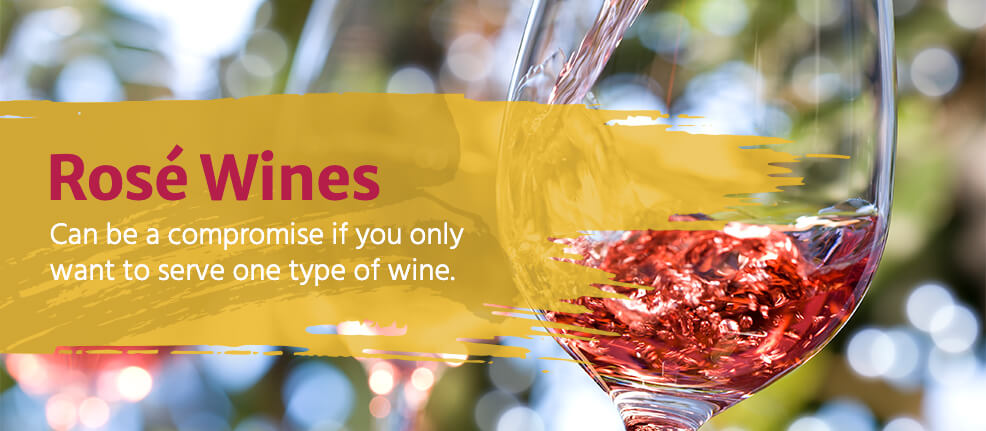
- Consider rosé: Rosés can be a compromise if you only want to serve one type of wine. A dry rosé gives the refreshing feel of white wine with the substance of red wine to stand up to the food you serve. Likewise, you could offer one red wine, one white wine and one rosé varietal just to cover your bases.
- Balance sweet and dry: Serving more than one red or white varietal? Ensure one type is dry while the other runs sweet. This flavor contrast is one of the major factors people consider when determining their wine preferences. Some wine drinkers only like dry wines, while others prefer varieties on the sweeter side. Offering one dry and one sweet white wine, as well as one dry and one sweet red wine, caters to a wider group of your guests. You don’t have to choose the driest white wine and the sweetest white wine available. Simply choose something from the dry end of the scale and something from the sweet end.
Buying Your Own Wine and Champagne Versus Order Through a Caterer
You have two main options when deciding where to buy wine and champagne for wedding events — ordering through your venue or caterer or buying your own wine cases.
Buying your own beverages gives you control over exact brands and varietals. You can also usually find better prices from outside vendors and retailers. Ordering wine and champagne through your caterer may cost you about double the retail price for that specific bottle. Sorry, bank account.
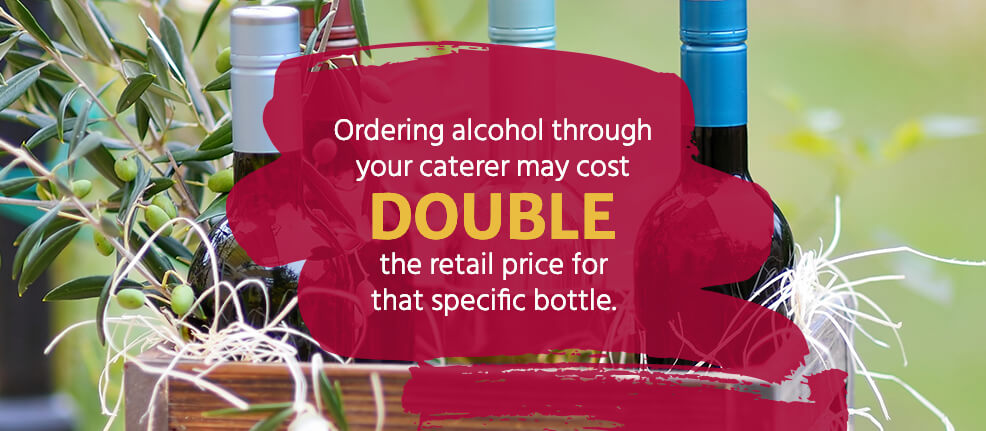
However, not all venues or caterers allow you to purchase and serve your own alcohol. Always check with both the venue and the caterer before researching and buying your own wine. No matter how much you love a glass of vino, you don’t want to waste your wedding funds on cases of wine you can’t use on your big day.
1. Pros of Ordering Alcohol Through Your Caterer
Opting for a venue’s or caterer’s alcohol menu includes perks like:
- You don’t have to research and compare pricing from multiple vendors. This saves you time and lets you focus on other wedding priorities not outsourceable.
- The caterer handles ordering and getting the wine to the venue. No hauling heavy cases of wine to your wedding reception location.
- You avoid a corkage fee. Sometimes caterers charge a corkage fee to open and pour your own wine and champagne. That corkage fee can be over $15 per bottle.
2. Pros of Supplying Your Own Wedding Alcohol
Now, let’s explore the pros of buying your own wine and champagne:
- You aren’t limited to the options provided by the caterer. While caterers often maintain dynamic wine selections, they can offer limited champagne and sparkling wine catalogs. A retailer will have a much wider selection without requiring expensive special orders.
- Wine and champagne are much cheaper, since caterers mark up their prices. If your caterer charges a corkage fee, compare the cost of their wine to the cost of your wine plus the fee. You may still come out ahead if you find a good third-party deal. In general, the more expensive the wine, the more you save by purchasing it yourself and paying the corkage fee. Wine under $15 per bottle may be cheaper when ordered through your caterer. Try to negotiate a lower corkage fee to make your savings even greater.
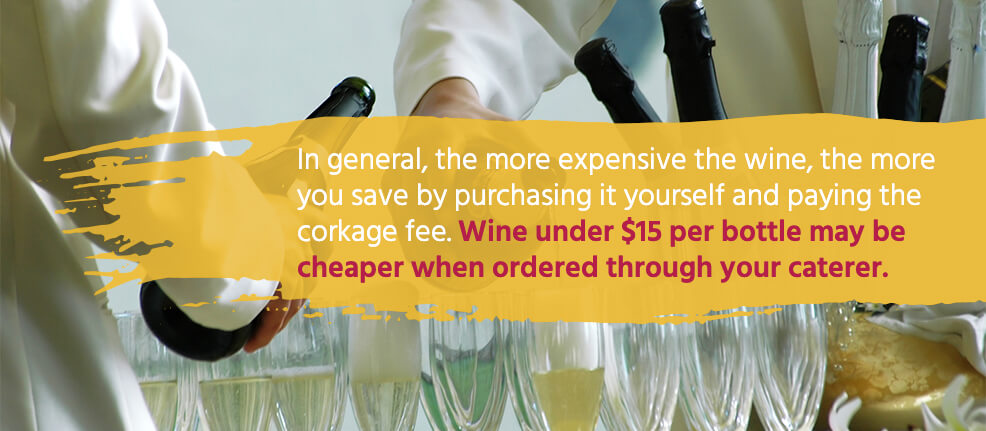
- You can buy in bulk: Buying in bulk often means you get a discount on wine, making it even more affordable. Many retailers offer discounts of around 10% when you order a case or more of wine at once. Buying wine yourself is already cheaper, but this discount shaves even more money off the cost, giving you more room in your budget.
Extra Tips for Choosing Wine and Champagne for Your Reception
Use your wine and champagne menu to add that special touch to your wedding day. Consider customizing the presentation of bottles at the bar in a unique way. Print signs to place on the tables or at the bar sharing why you chose this particular varietal.
Get creative! There are so many ways you can use wine and champagne to add another layer of detail to your special day.
- Wine with personal meaning: Choose a wine with significant meaning to you as a couple. Think of what you drank on your first date, first anniversary or the day you got engaged. If you can’t find or afford that specific brand in bulk, you can still use the same wine varietal, such as cabernet sauvignon, pinot grigio or malbec, for a walk down memory lane.
- Family heritage inspiration: If you don’t have any specific wine preferences, choose varieties from countries that represent your heritage. Many countries now produce distinct wines, giving you a world of possibilities.
- Local wine: Wine is produced in nearly every region in the U.S. Consider choosing bottles from a favorite local winery or from a region you vacation frequently, solo or together. If you have multiple favorite vacation spots, choose a few different varieties from those spots and display them alongside vacation photos.
- Personalized labels: No matter where wine or champagne comes from, an easy way to add a personal touch is to decorate them with custom labels. Include your names, the wedding date, the wedding location and anything else you want to commemorate.
Tips for Buying the Right Amount of Alcohol for Your Wedding
With wine and champagne selected, it’s time to purchase the wine. If you decide to buy through your caterer, the company will handle all further logistics. When buying your own wine, you need to handle vendor research, purchasing and transportation to your final venue.
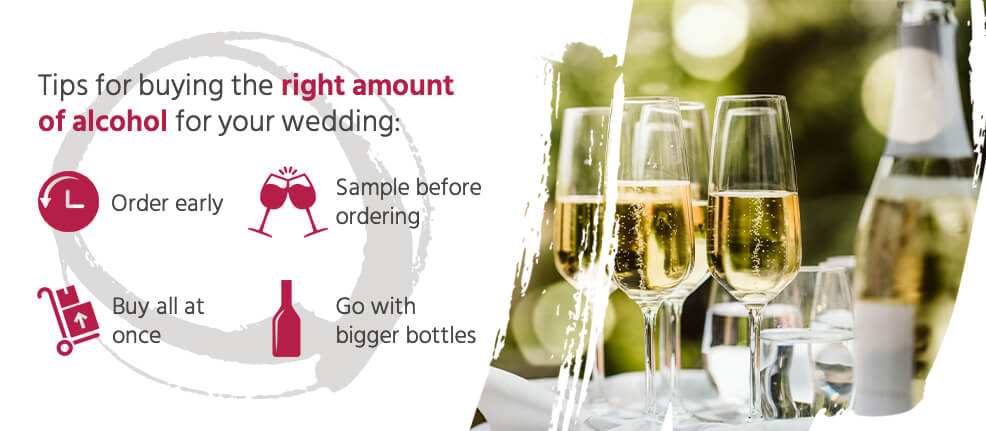
Follow these general best practices when it comes to ordering the ideal amount of wedding alcohol:
- Order early: Comparing prices and finding the specific brands you enjoy takes time. Start early to find the best pricing. Plus, orders may require a few extra days or even weeks if sourcing bottles from a particular region. Check with the retailer to determine how soon you need to order.
- Sample before ordering: The same varietal can taste dramatically different depending on where it comes from, grape growing conditions and aging techniques. For example, you may love a malbec from one winery or country but dislike its flavor from another. Always try before you buy your dozen-or-so cases.
- Go with bigger bottles: If you’re paying a per-bottle corkage fee, buying larger bottles of wine decreases your total fee. Those larger bottles may also be more inexpensive per ounce. Compare pricing if larger bottles are available in the variety of wine you want to serve.
- Buy all at once: Placing one large order for all the wine and champagne for your wedding can save you a serious chunk of change. That’s because most wine retailers offer bulk discounts. The larger your order, the larger your savings.
Select Your Wedding’s Wine and Champagne
If you’re ready to buy your own wine for your upcoming wedding, check out Marketview Liquor. We offer case discounts, including on mix-and-match varietals, plus free shipping on twelve or more bottles of wedding wine and champagne marked “Eligible for Free Shipping.”
Our wide selection of sparkling wine and champagne gives you the variety you want at a price you need — no compromises.
At Marketview Liquor, we can also help you plan the wine and liquor for your wedding reception. Give us a call at 888-427-2480 or email us at customerservice@marketviewliquor.com to start planning the wine and champagne for your wedding!
